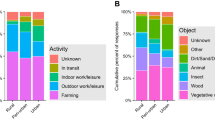Abstract
The frequency and causes of visually significant corneal opacification in central Tanzania was assessed by a population-based survey. The overall prevalence of bilateral corneal opacification was 1.16% (95% CI 0.31–1.44) and unilateral corneal opacification was 2.07% (95% CI 1.55–2.73). Bilateral corneal opacification was most frequently associated with trachoma, keratoconjunctivitis, vitamin A deficiency and measles. Unilateral corneal opacification had similar causes with the addition of cases caused by trauma. Corneal scarring is a frequent occurence in this region. The majority of cases of corneal opacification are secondary to potentially preventable or treatable causes.
Similar content being viewed by others
References
Rapoza PA, West SK, Katala SJ, Taylor HR. Prevalence and causes of vision loss in central Tanzania. International Ophthalmol 1991; 15:123–9.
Foster A, Sommer A. Childhood blindness from corneal ulceration in Africa: Causes, prevention, and treatment. Bull WHO 1986; 64: 619–23.
Foster A, Kavishe F, Sommer A, Taylor HR. A simple surveillance system for xerophthalmia and childhood corneal ulceration. Bull WHO 1986; 64: 725–8.
Taylor HR, Rapoza PA, West SK, et al. The epidemiology of infection in trachoma. Invest Ophthalmol Vis Sci 1989; 30: 1823–33.
Taylor HR, West SK, Katala SJ, Foster A. Trachoma: Evaluation of a new grading scheme in the United Republic of Tanzania. Bull WHO 1987; 65:485–8.
Barclay A, Foster A, Sommer A. Vitamin A supplements and mortality related to measles: A randomized clinical trial. Br Med J 1987; 294: 294–7.
Reacher MH, Huber MJ, Canagaratnam R, Alghassany A. A trial of surgery for trichiasis of the upper lid from trachoma. Br J Ophthalmol 1990; 74:109–13.
Foster A, Sommer A. Corneal blindness from corneal ulceration in Africa: Causes, prevention, and treatment. Bull WHO 1986; 64: 619–23.
Taylor HR, Cadet JC, Sommer A. Folk medicines and acute hemorrhagic conjunctivitis. Am J Ophthalmol 1982; 94: 559–60.
Author information
Authors and Affiliations
Rights and permissions
About this article
Cite this article
Rapoza, P.A., West, S.K., Katala, S.J. et al. Etiology of corneal opacification in central Tanzania. Int Ophthalmol 17, 47–51 (1993). https://doi.org/10.1007/BF00918868
Accepted:
Issue Date:
DOI: https://doi.org/10.1007/BF00918868




